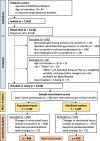Covid-19 pandemic-related changes in teleworking, emotional exhaustion, and occupational burnout: a cross-sectional analysis of a cohort study
- PMID: 39849408
- PMCID: PMC11756113
- DOI: 10.1186/s12889-024-21142-z
Covid-19 pandemic-related changes in teleworking, emotional exhaustion, and occupational burnout: a cross-sectional analysis of a cohort study
Abstract
Background: The COVID-19 pandemic prompted significant shifts to teleworking, raising questions about potential impacts on employee wellbeing. This study examined the association between self-reported changes to teleworking frequency (relative to before the pandemic) and two indicators of occupational burnout: emotional exhaustion and professionally diagnosed burnout.
Methods: Data were derived from two samples from a digital cohort study based in Geneva, Switzerland: one population-based, and one from a sample of workers who were likely mobilized in the early stages of the COVID-19 pandemic. Emotional exhaustion was measured using the Maslach Burnout Inventory (EE-MBI), while self-reported diagnosed burnout was assessed by asking participants if they had received a professional diagnosis of occupational burnout within the previous 12 months. Participants were categorized based on self-reported telework frequency changes: "no change," "increase," "decrease," "never telework," and "not possible to telework." Adjusted regression models for each of the study samples were used to estimate associations between telework changes and burnout outcomes, accounting for sociodemographic, household, and work-related factors.
Results: In the population-based sample of salaried employees (n = 1,332), the median EE-MBI score was 14 (interquartile range: 6-24), and 7.3% reported diagnosed burnout. Compared to those reporting no change in telework frequency (19% of the sample), those reporting a decrease (4%) and those reporting that teleworking was not possible (28.7%) had significantly higher emotional exhaustion scores (adjusted beta (aβ) 5.26 [95% confidence interval: 1.47, 9.04] and aβ 3.51 [0.44, 6.59], respectively) and additionally reported higher odds of diagnosed burnout (adjusted odds ratio (aOR) 10.59 [3.24, 34.57] and aOR 3.42 [1.22, 9.65], respectively). "Increased" (28.9%) and "never" (19.4%) telework statuses were not significantly associated with burnout outcomes. These trends were mirrored in the "mobilized-workers" sample, with the exception that those reporting that teleworking was not possible did not report significantly higher odds of diagnosed burnout compared to those reporting no change in telework frequency.
Conclusions: Decreased teleworking frequency and not having the possibility of telework were associated with higher emotional exhaustion and diagnosed burnout. As organizations reconsider their telework policies in a post-pandemic era, they should consider the impact of such organizational changes on employee wellbeing.
Keywords: Diagnosed burnout; Emotional exhaustion; Organizational change; Remote work; Work from home.
© 2025. The Author(s).
Conflict of interest statement
Declarations. Ethics approval and consent to participate: This study was carried out in accordance with the Declaration of Helsinki. The Specchio-COVID19 study was approved by the Cantonal Research Ethics Commission of Geneva (CCER project ID 2020–00881). All participants provided electronic informed consent to participate in the digital cohort. Consent for publication: Not applicable. Competing interests: The authors declare no competing interests.
Figures



References
-
- Ahola K, Honkonen T, Isometsä E, Kalimo R, Nykyri E, Koskinen S, et al. Burnout in the general population. Soc Psychiatry Psychiatr Epidemiol. 2006;41(1):11–7. - PubMed
-
- Al-Gobari M, Shoman Y, Blanc S, Canu IG. Point prevalence of burnout in Switzerland: a systematic review and meta-analysis. Swiss Med Wkly. 2022;152: w30229. - PubMed
MeSH terms
LinkOut - more resources
Full Text Sources
Medical
Research Materials

